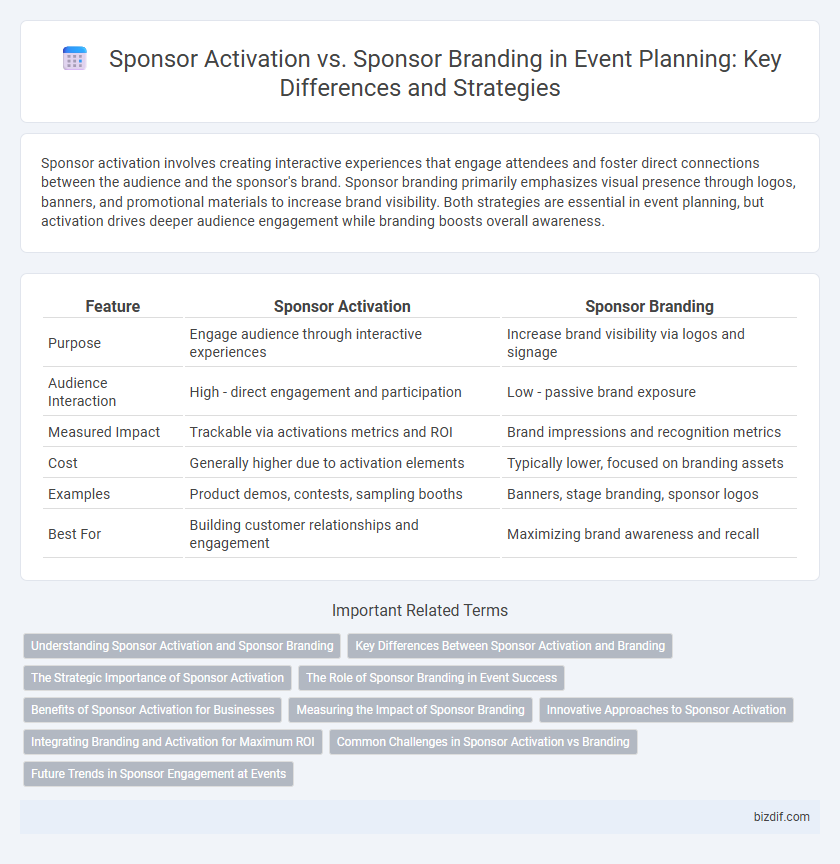Sponsor activation involves creating interactive experiences that engage attendees and foster direct connections between the audience and the sponsor's brand. Sponsor branding primarily emphasizes visual presence through logos, banners, and promotional materials to increase brand visibility. Both strategies are essential in event planning, but activation drives deeper audience engagement while branding boosts overall awareness.
Table of Comparison
| Feature | Sponsor Activation | Sponsor Branding |
|---|---|---|
| Purpose | Engage audience through interactive experiences | Increase brand visibility via logos and signage |
| Audience Interaction | High - direct engagement and participation | Low - passive brand exposure |
| Measured Impact | Trackable via activations metrics and ROI | Brand impressions and recognition metrics |
| Cost | Generally higher due to activation elements | Typically lower, focused on branding assets |
| Examples | Product demos, contests, sampling booths | Banners, stage branding, sponsor logos |
| Best For | Building customer relationships and engagement | Maximizing brand awareness and recall |
Understanding Sponsor Activation and Sponsor Branding
Sponsor activation involves engaging event attendees through interactive experiences that create a deeper connection with the brand, enhancing recall and emotional impact. Sponsor branding focuses on the visibility of the sponsor's logo and messaging, aiming to build brand awareness through prominent placement within the event environment. Effective event planning balances sponsor activation and branding to maximize sponsor value and audience engagement.
Key Differences Between Sponsor Activation and Branding
Sponsor activation involves engaging audiences through interactive experiences and direct participation, driving measurable consumer interaction and brand recall. Sponsor branding focuses on visual presence via logos, signage, and media to enhance brand visibility and awareness throughout the event. The key difference lies in activation's emphasis on experiential marketing versus branding's focus on static exposure and recognition.
The Strategic Importance of Sponsor Activation
Sponsor activation drives meaningful engagement by transforming passive branding into interactive experiences that deepen audience connection and enhance brand recall. Unlike traditional sponsor branding, which primarily offers visibility through logos and signage, activation leverages targeted campaigns, on-site activities, and digital integration to create memorable touchpoints. This strategic approach not only maximizes return on investment but also fosters long-term loyalty and measurable impact in event sponsorship.
The Role of Sponsor Branding in Event Success
Sponsor branding plays a crucial role in event success by enhancing brand visibility and creating lasting impressions among target audiences. Effective branding strategies leverage logos, messaging, and interactive experiences to integrate sponsors seamlessly into the event environment, increasing attendee engagement and sponsor ROI. This strategic branding fosters stronger brand recall and establishes valuable connections between the sponsor and the event's demographic, driving long-term partnership opportunities.
Benefits of Sponsor Activation for Businesses
Sponsor activation drives direct engagement by creating interactive experiences that enhance brand recall and foster emotional connections with target audiences. This approach generates measurable ROI through increased sales, social media exposure, and lead generation, outperforming passive sponsor branding. Businesses benefit from heightened visibility and customer loyalty by transforming sponsorships into dynamic marketing opportunities.
Measuring the Impact of Sponsor Branding
Measuring the impact of sponsor branding involves analyzing key performance indicators such as brand recall, audience engagement, and conversion rates during and after an event. Metrics like social media mentions, attendee surveys, and digital impressions provide data-driven insights into brand visibility and sentiment. Effective tracking of these indicators helps event planners optimize sponsor branding strategies and demonstrate return on investment to stakeholders.
Innovative Approaches to Sponsor Activation
Innovative approaches to sponsor activation leverage immersive technologies, such as augmented reality and interactive installations, to create memorable brand experiences that go beyond traditional sponsor branding. These activation strategies foster deeper audience engagement by encouraging participation and emotional connection, driving higher brand recall and loyalty. Metrics like real-time social media interaction, event app engagement, and on-site activation dwell time provide quantifiable insights into the effectiveness of sponsor activations.
Integrating Branding and Activation for Maximum ROI
Integrating sponsor activation with branding strategies enhances event ROI by creating immersive experiences that reinforce brand identity and engage attendees. Activation focuses on interactive elements that drive consumer participation, while branding ensures consistent visual and messaging presence throughout the event. Combining these approaches maximizes sponsor visibility and fosters meaningful connections, leading to higher engagement and measurable returns.
Common Challenges in Sponsor Activation vs Branding
Sponsor activation often faces challenges such as engaging target audiences effectively and measuring return on investment, while sponsor branding struggles with achieving consistent brand visibility and association throughout the event. Both activation and branding require seamless coordination between event organizers and sponsors to avoid misalignment of goals and diluted messaging. Limited budgets and time constraints further complicate the execution of impactful activation experiences and memorable brand placements.
Future Trends in Sponsor Engagement at Events
Sponsor activation focuses on creating interactive experiences that drive attendee engagement and measurable ROI, while sponsor branding emphasizes visual presence and long-term brand recognition. Future trends in sponsor engagement at events highlight the integration of immersive technologies like AR and VR to enhance experiential activations, alongside data-driven strategies for personalized interactions. Event planners increasingly leverage AI analytics to optimize sponsor activations, ensuring real-time audience targeting and maximizing engagement impact beyond traditional branding efforts.
Sponsor activation vs Sponsor branding Infographic

 bizdif.com
bizdif.com